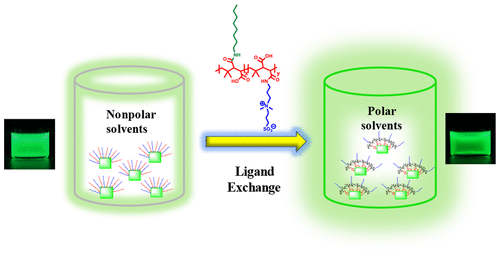当前位置:
X-MOL 学术
›
J. Am. Chem. Soc.
›
论文详情
Our official English website, www.x-mol.net, welcomes your
feedback! (Note: you will need to create a separate account there.)
Enhanced Stabilization and Easy Phase Transfer of CsPbBr3 Perovskite Quantum Dots Promoted by High Affinity Polyzwitterionic Ligands
Journal of the American Chemical Society ( IF 14.4 ) Pub Date : 2020-06-26 , DOI: 10.1021/jacs.0c03682 Sisi Wang 1 , Liang Du 1 , Zhicheng Jin 1 , Yan Xin 2 , Hedi Mattoussi 1
Journal of the American Chemical Society ( IF 14.4 ) Pub Date : 2020-06-26 , DOI: 10.1021/jacs.0c03682 Sisi Wang 1 , Liang Du 1 , Zhicheng Jin 1 , Yan Xin 2 , Hedi Mattoussi 1
Affiliation

|
The successful growth of colloidal lead halide perovskite quantum dots (PQDs) has generated tremendous interest in the community, due to some of their unique properties and the promise they offer for use in applications involving light emitting devices and solar cell technology. However, tangible progress in probing their fundamental properties and/or their integration into optoelectronic devices, has been hampered by issues of colloidal and photophysical instability. Here, we introduce a promising surface coating strategy relying on a poly-zwitterionic polymer, where high affinity binding onto the QDs is driven by multi-coordinating electrostatic interactions with the ion-rich surfaces of CsPbBr3 PQDs. The polymer ligands were synthesized by installing a stoichiometric mixture of amine-modified sulfobetaine anchors and solubilizing motifs on a poly(isobutylene-alt-maleic anhydride), PIMA, via nucleophilic addition reaction. We find that this coating approach imparts enhanced colloidal and photophysical stability to the nanocrystals over a broad range of solvent conditions and in powder form. This approach also allows easy phase transfer of the PQDs from non-polar media to an array of solutions with varying polarities and properties. Additionally, the stabilization strategy preserves the photophysical and structural characteristics of the nanocrystals over a period extending to 1.5 years under certain conditions.
中文翻译:

高亲和力多两性离子配体促进 CsPbBr3 钙钛矿量子点的增强稳定性和易相转移
胶体卤化铅钙钛矿量子点 (PQD) 的成功增长引起了社区的极大兴趣,因为它们具有一些独特的特性,并且有望用于涉及发光器件和太阳能电池技术的应用。然而,探索它们的基本特性和/或将它们集成到光电器件中的实际进展受到胶体和光物理不稳定性问题的阻碍。在这里,我们介绍了一种有前途的表面涂层策略,它依赖于多两性离子聚合物,其中与 QD 的高亲和力结合是由与 CsPbBr3 PQD 的富离子表面的多配位静电相互作用驱动的。聚合物配体是通过在聚(异丁烯-alt-马来酸酐)PIMA 上通过亲核加成反应安装胺改性磺基甜菜碱锚和增溶基序的化学计量混合物来合成的。我们发现这种涂层方法在广泛的溶剂条件和粉末形式下赋予纳米晶体增强的胶体和光物理稳定性。这种方法还允许 PQD 从非极性介质轻松相转移到具有不同极性和性质的溶液阵列。此外,在某些条件下,稳定化策略可在长达 1.5 年的时间内保持纳米晶体的光物理和结构特性。我们发现这种涂层方法在广泛的溶剂条件和粉末形式下赋予纳米晶体增强的胶体和光物理稳定性。这种方法还允许 PQD 从非极性介质轻松相转移到具有不同极性和性质的溶液阵列。此外,在某些条件下,稳定化策略可在长达 1.5 年的时间内保持纳米晶体的光物理和结构特性。我们发现这种涂层方法在广泛的溶剂条件和粉末形式下赋予纳米晶体增强的胶体和光物理稳定性。这种方法还允许 PQD 从非极性介质轻松相转移到具有不同极性和性质的溶液阵列。此外,在某些条件下,稳定化策略可在长达 1.5 年的时间内保持纳米晶体的光物理和结构特性。
更新日期:2020-06-26
中文翻译:

高亲和力多两性离子配体促进 CsPbBr3 钙钛矿量子点的增强稳定性和易相转移
胶体卤化铅钙钛矿量子点 (PQD) 的成功增长引起了社区的极大兴趣,因为它们具有一些独特的特性,并且有望用于涉及发光器件和太阳能电池技术的应用。然而,探索它们的基本特性和/或将它们集成到光电器件中的实际进展受到胶体和光物理不稳定性问题的阻碍。在这里,我们介绍了一种有前途的表面涂层策略,它依赖于多两性离子聚合物,其中与 QD 的高亲和力结合是由与 CsPbBr3 PQD 的富离子表面的多配位静电相互作用驱动的。聚合物配体是通过在聚(异丁烯-alt-马来酸酐)PIMA 上通过亲核加成反应安装胺改性磺基甜菜碱锚和增溶基序的化学计量混合物来合成的。我们发现这种涂层方法在广泛的溶剂条件和粉末形式下赋予纳米晶体增强的胶体和光物理稳定性。这种方法还允许 PQD 从非极性介质轻松相转移到具有不同极性和性质的溶液阵列。此外,在某些条件下,稳定化策略可在长达 1.5 年的时间内保持纳米晶体的光物理和结构特性。我们发现这种涂层方法在广泛的溶剂条件和粉末形式下赋予纳米晶体增强的胶体和光物理稳定性。这种方法还允许 PQD 从非极性介质轻松相转移到具有不同极性和性质的溶液阵列。此外,在某些条件下,稳定化策略可在长达 1.5 年的时间内保持纳米晶体的光物理和结构特性。我们发现这种涂层方法在广泛的溶剂条件和粉末形式下赋予纳米晶体增强的胶体和光物理稳定性。这种方法还允许 PQD 从非极性介质轻松相转移到具有不同极性和性质的溶液阵列。此外,在某些条件下,稳定化策略可在长达 1.5 年的时间内保持纳米晶体的光物理和结构特性。











































 京公网安备 11010802027423号
京公网安备 11010802027423号